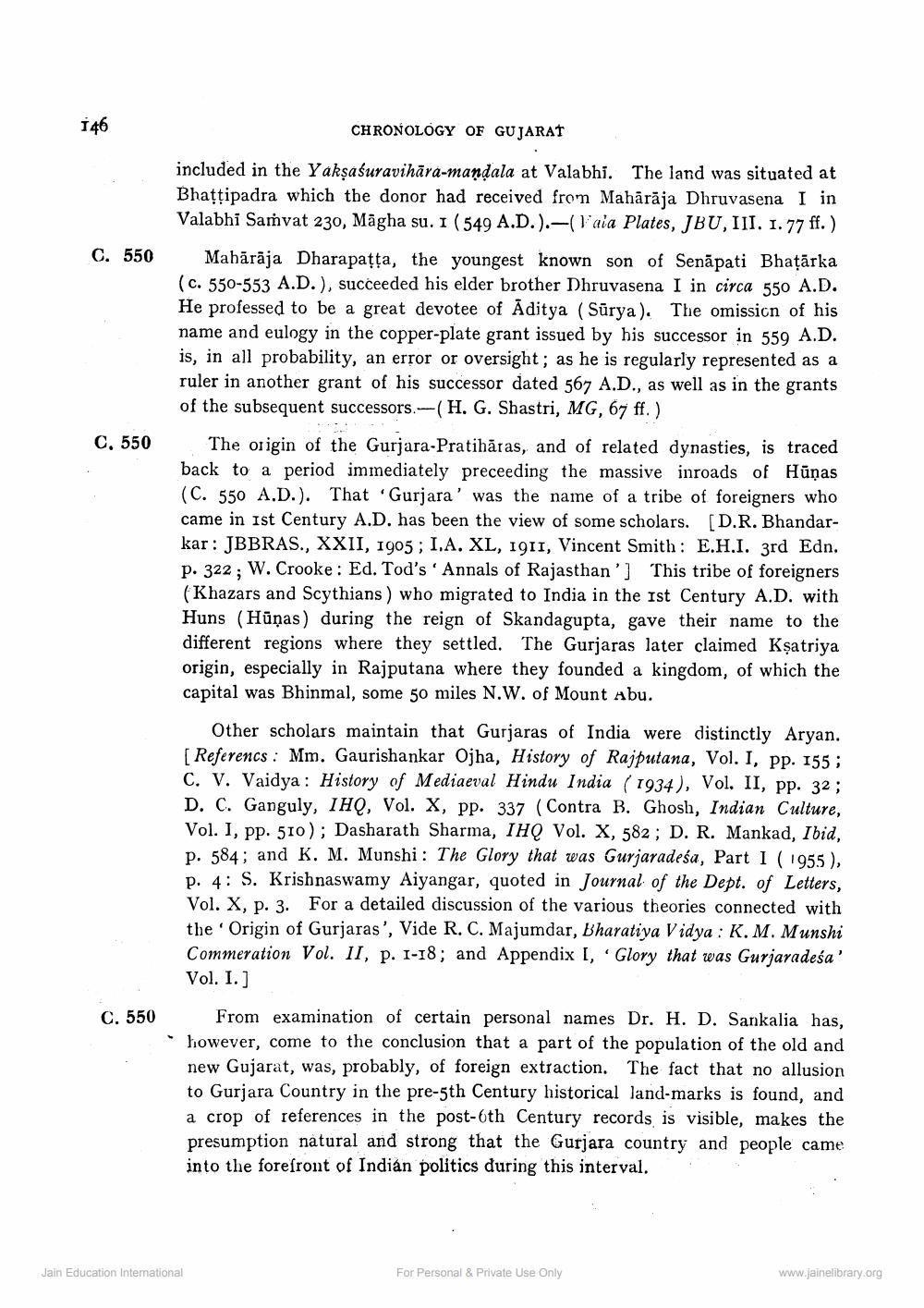________________
146
CHRONOLOGY OF GUJARAT
C. 550
included in the Yakşaśuravihāra-mandala at Valabhi. The land was situated at Bhattipadra which the donor had received from Mahārāja Dhruvasena I in Valabhi Samvat 230, Māgha su. I ( 549 A.D.).-(l'aia Plates, JBU, III. 1.77 ff.)
Mahārāja Dharapațța, the youngest known son of Senāpati Bhațārka (c. 550-553 A.D.), succeeded his elder brother Dhruvasena I in circa 550 A.D. He professed to be a great devotee of Aditya (Sürya). The omission of his name and eulogy in the copper-plate grant issued by his successor in 559 A.D. is, in all probability, an error or oversight; as he is regularly represented as a ruler in another grant of his successor dated 567 A.D., as well as in the grants of the subsequent successors.--(H. G. Shastri, MG, 67 ff.)
The origin of the Gurjara-Pratihāras, and of related dynasties, is traced back to a period immediately preceeding the massive inroads of Hūnas (C. 550 A.D.). That Gurjara' was the name of a tribe of foreigners who came in Ist Century A.D. has been the view of some scholars. (D.R. Bhandarkar: JBBRAS., XXII, 1905; I.A. XL, 1911, Vincent Smith: E.H.I. 3rd Edn. p. 322; W. Crooke : Ed. Tod's 'Annals of Rajasthan'] This tribe of foreigners (Khazars and Scythians) who migrated to India in the ist Century A.D. with Huns (Hūņas) during the reign of Skandagupta, gave their name to the different regions where they settled. The Gurjaras later claimed Ksatriya origin, especially in Rajputana where they founded a kingdom, of which the capital was Bhinmal, some 50 miles N.W. of Mount Abu.
C. 550
Rajpuhey sets of Sko
Other scholars maintain that Gurjaras of India were distinctly Aryan. [Referencs : Mm. Gaurishankar Ojha, History of Rajputana, Vol. I, pp. 155; C. V. Vaidya : History of Mediaeval Hindu India (1934), Vol. II, pp. 32; D. C. Ganguly, IHQ, Vol. X, pp. 337 (Contra B. Ghosh, Indian Culture, Vol. I, pp. 510); Dasharath Sharma, IHQ Vol. X, 582; D. R. Mankad, Ibid, p. 584; and K. M. Munshi: The Glory that was Gurjaradeśa, Part 1 (1955), p. 4: S. Krishnaswamy Aiyangar, quoted in Journal of the Dept. of Letters, Vol. X, p. 3. For a detailed discussion of the various theories connected with the Origin of Gurjaras', Vide R. C. Majumdar, Bharatiya Vidya : K.M. Munshi Commeration Vol. II, p. 1-18; and Appendix I, Glory that was Gurjaradeśa' Vol. I. ]
C. 550
From examination of certain personal names Dr. H. D. Sankalia has, however, come to the conclusion that a part of the population of the old and new Gujarat, was, probably, of foreign extraction. The fact that no allusion to Gurjara Country in the pre-5th Century historical land-marks is found, and a crop of references in the post-6th Century records is visible, makes the presumption natural and strong that the Gurjara country and people came into the forefront of Indian politics during this interval.
Jain Education International
For Personal & Private Use Only
www.jainelibrary.org




